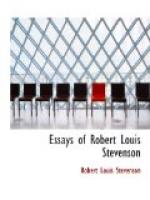[Note 16: Mr. Trollope’s ... chronicling small beer ... Rawdon Crawley’s blow. Anthony Trollope (1815-1882) wrote an immense number of mildly entertaining novels concerned with the lives and ambitions of English clergymen and their satellites. His best-known book is probably Barchester Towers (1857).... Chronicling small beer is the “lame and impotent conclusion” with which Iago finishes his poem (Othello, Act II, Sc. I).... Rawdon Crawley’s blow refers to the most memorable scene in Thackeray’s great novel, Vanity Fair (1847-8), where Rawdon Crawley, the husband of Becky Sharp, strikes Lord Steyne in the face (Chap. LIII). After writing this powerful scene, Thackeray was in a state of tremendous excitement, and slapping his knee, said, “That’s Genius!”]
[Note 17: The end of Esmond ... pure Dumas. Thackeray’s romance Henry Esmond (1852) is regarded by many critics as the greatest work of fiction in the English language; Stevenson here calls it “the best of all his books.” The scene Stevenson refers to is where Henry is finally cured of his love for Beatrix, and theatrically breaks his sword in the presence of the royal admirer (Book III, Chap. 13). Alexander Dumas (1803-1370), author of Monte Cristo and Les Trois Mousquetaires. Stevenson playfully calls him “the great, unblushing French thief”; all he means is that Dumas never hesitated to appropriate material wherever he found it, and work it into his romances.]
[Note 18: The living fame of Robinson Crusoe with the discredit of Clarissa Harlowe. A strong contrast between the romance of incident and the analytical novel. For remarks on Clarissa, see our Note 9 of Chapter IV above.]
[Note 19: Byronism. About the time Lord Byron was publishing Childe Harold (1812-1818) a tremendous wave of romantic melancholy swept over all the countries of Europe. Innumerable poems and romances dealing with mysteriously-sad heroes were written in imitation of Byron; and young authors wore low, rolling collars, and tried to look depressed. See Gautier’s Histoire du Romantisme. Now the death of Lovelace (in a duel) in Richardson’s Clarissa, was pitched in exactly the Byronic key, though at that time Byron had not been born.... The Elizabethans were of course thoroughly romantic.]
[Note 20: Faria..._Dantes_. Characters in Dumas’s Monte Cristo (1841-5).]
[Note 21: Lucy and Richard Feveril. Usually spelled “Feverel.” Stevenson strangely enough, was always a bad speller. The reference here is to one of Stevenson’s favorite novels The Ordeal of Richard Feverel (1859) by George Meredith. Stevenson’s idolatrous praise of this particular scene in the novel is curious, for no greater contrast in English literary style can be found than that between Meredith’s and his own. For another reference by Stevenson to the older novelist, see our Note 47 of Chapter IV above.]




